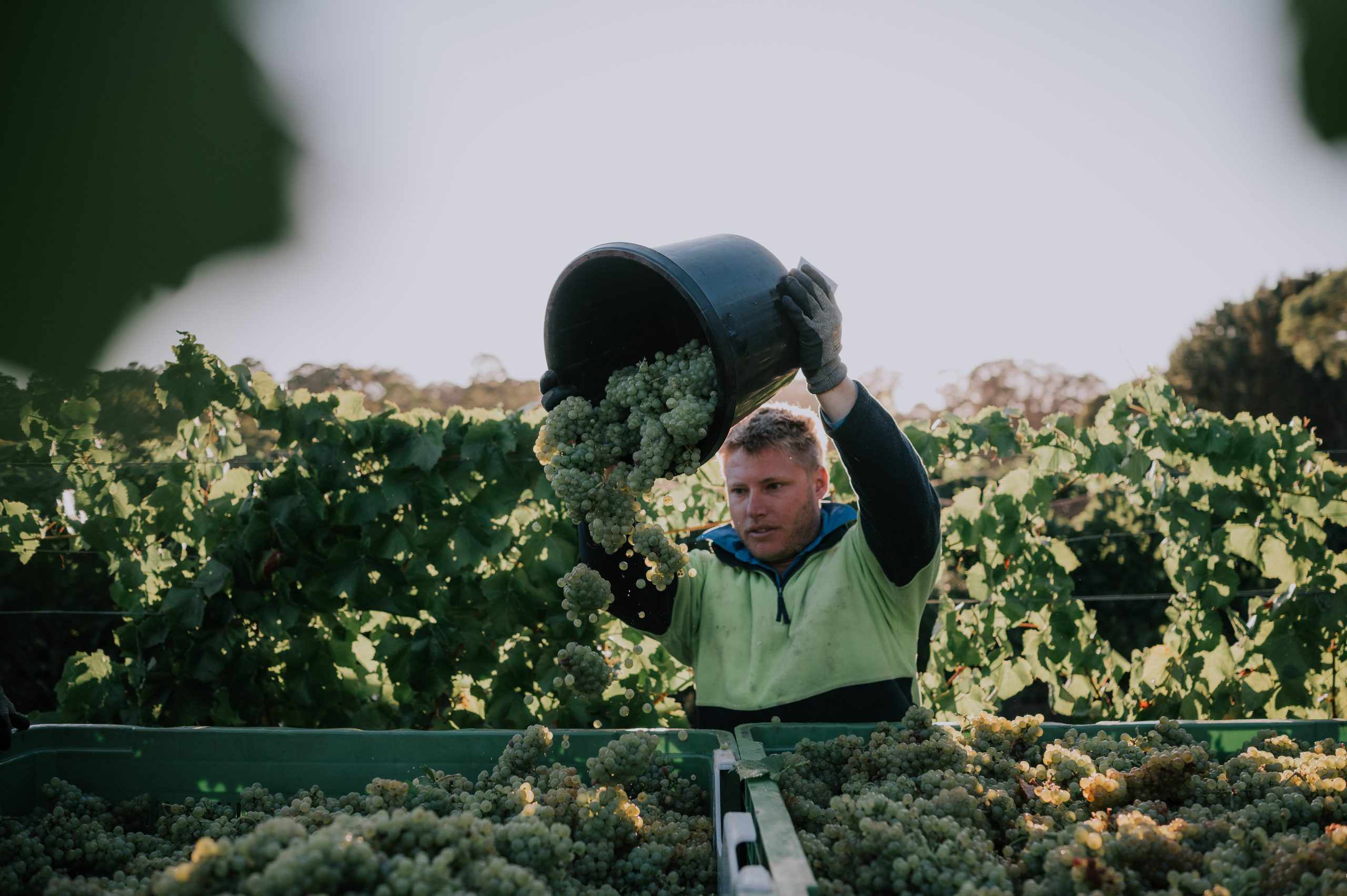Harvesting Chardonnay at the Gnarawary Vineyard. Photo courtesy of Vasse Felix/Margaret River Wine.
2023 proved to be an extended yet very rewarding vintage in the Margaret River Wine Region. Optimal, dry weather conditions paired with the absence of any significant climatic challenges or disease pressure set the scene for a moderate season, ideal for gentle, consistent ripening across all varieties.
A slightly cool, delayed start
Winter temperatures were lower than average, which made for a quick senescence and sound dormancy for the vines. There was markedly less-than-average rain; however, the vineyards received sufficient supply to recharge soil moisture levels, paving the way for a promising growing season ahead.
The growing season began with a late budburst after a relatively cold winter that pushed vine development back by about 2-3 weeks. Spring saw less rain and cooler conditions than usual, resulting in a slow start to canopy growth and an extended flowering period for early bloomers like Chardonnay. Good fruit-set across most varieties resulted in generally higher yields than average.
Consistently warm, dry summer
Low November rain slowed into an even drier December, January and February, with less than 2 mL of rain falling collectively across the summer season. January brought consistently warm, sunny days, which saw vines start to catch up nicely on their development. Veraison was delayed by 2-3 weeks for whites and one week for reds. February, dry with plenty of sunshine and no extreme heat, provided perfect ripening conditions and harvest starting around the middle of the month.
Cold southerly breezes blowing off the ocean and cool mornings, evenings and nights helped retain natural acid in the fruit. At the same time, short periods of peak heat during the day were ideal for slow, even ripening across all varieties.
Disease pressure was minimal in the region due to seasonal consistency and dry conditions stretching from January until the middle of April. The Marri tree blossom was scarce this year, which made grapes an easy target for the native birds, and as a result, bird netting and monitoring were vital.
Reds roll off gracefully
The warm, dry conditions that kicked off the season continued for most of the reds, with Shiraz and Cabernet Sauvignon rolling off the vine gracefully. Temperatures were a bit cooler in April, meaning it took longer for tannins to soften and for flavour to develop fully. However, the
Alex Miller, Technical Viticulturist at Voyager Estate, explained, “What started as a slow burn in spring for the viticulturists resulted in a glorious summer of optimal temperatures, rewarding us with classy fruit befitting our regional reputation. April evolved into a typical patchy weather pattern as producers raced against the season’s end. Fortunately, Cabernet Sauvignon berry skins are sturdy and can withstand the dip in temperature and the odd shower. All round, another epic vintage in the bank”.
2023: An excellent vintage
Despite minor weather events towards the end, 2023 proved a fantastic vintage. As winemakers taste the wines as they finish fermentation, they can already see the incredible quality of what has come off the vineyards. The region’s hero varieties, Chardonnay and Cabernet Sauvignon, stand out for vintage 2023. The Chardonnays are elegant and fresh with lovely natural acidity. The Cabernet Sauvignons are inky and dense, showing great intensity and a very fine tannin structure.
The region’s volume is estimated to be approximately 34,000 tonnes this year, and 6% higher than the 5-year average. The increased yields and superb quality across the region bode well for the 2023 vintage wines.
“In summary, 2023 will be remembered as an excellent vintage in Margaret River.” writes Glenn Goodall.
Sustainability surged across Margaret River in 2023
For Vintage 2023, Margaret River vineyards and wineries participating in Sustainable Winegrowing Australia grew significantly to 96 members.
The 47 Certified Vineyards Members account for 1,876 hectares or 32% of Margaret River’s vineyards. An additional 22 vineyards are working towards certification. Margaret River also boasts 13 Certified Wineries that crushed 14,641 tonnes last year.
Margaret River Wine Association CEO Amanda Whiteland said, “Our Association’s Sustainability Plan was established out of a conviction to fulfil our custodial responsibilities. It recognises the importance of protecting our region’s rare biodiversity, exceptional environment value and capacity to produce some of the world’s best wines”.
“A major focus of the plan is onboarding our members to the national Sustainable Winegrowing Australia program, which aligns with the United Nations Sustainable Development Goals and focuses on soil, water, people, biodiversity, energy and waste. Kate Morgan, MRWA’s Sustainability Officer is working with members to achieve certification and build additional value for their wines,” Whiteland said.
Are you a Daily Wine News subscriber? If not, click here to join our mailing list. It’s free!





















